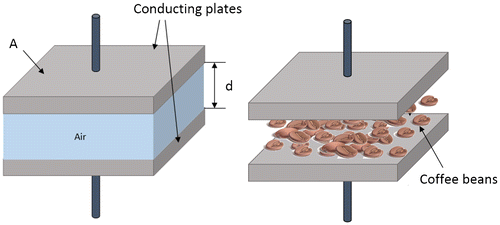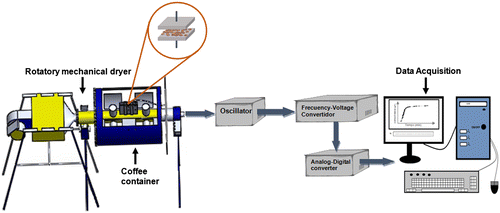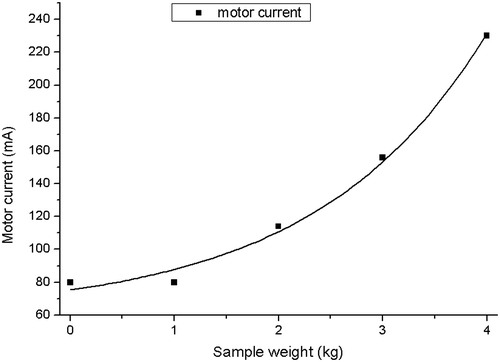 ?Mathematical formulae have been encoded as MathML and are displayed in this HTML version using MathJax in order to improve their display. Uncheck the box to turn MathJax off. This feature requires Javascript. Click on a formula to zoom.
?Mathematical formulae have been encoded as MathML and are displayed in this HTML version using MathJax in order to improve their display. Uncheck the box to turn MathJax off. This feature requires Javascript. Click on a formula to zoom.Abstract
The system presented estimates moisture in green coffee during drying process using two methods, which were capacitive sensors and mechanical load detection, to estimate it. Results show it is possible to determine coffee grains moisture from 40 to 10% humidity range, either by dielectric measurements, with a developed sensor, or dryer mechanical load, making it possible to get better storage conditions for coffee beans.
Keywords:
Public Interest Statement
Estimating moisture in coffee beans is of great importance due it helps with its storage and flavor; specialists have determined that to have a better product it is necessary to keep the humidity of the bean below 12%. Therefore, the present paper analyzed the precision of two methodologies, the approach of the first was to measure the effort the motor applied to move the coffee load which varies with the humidity of the load and the second approach is related to the ability of the coffee beans to conduct electrons to the plates of the sensors which store them temporary, making it possible to measure the energy stored.
Competing Interests
The authors declare no competing interest.
1. Introduction
Coffee consumption has globally grown; making it one of the leading reasons to find better ways to level up coffee grains quality, which means to keep physical and sensorial coffee properties. A critical step in coffee grains process is the drying stage, where most of the water contained is removed from grains, due to reducing moisture levels is key to ensuring the preservation of organoleptic properties during storage and further processing steps. Furthermore, if moisture content is high in green coffee, the possibilities of grain deterioration rises, because bacteria, mold or yeast can deteriorate grains easily when the water content is greater than 12% (Gautz, Smith, & Bittenbender, Citation2008).
It is also important for economics to ensure the correct moisture amount, considering that high humidity content causes coffee not to be economically rentable for producers.
Among the drying methods commonly implemented, the sun-drying is one of the most traditional ones, coffee beans are placed over extended areas under the sun, it is extensively implemented in developing countries by small producers, its main advantage is the low-cost energy used, though it requires long drying times (4–7 days or even more depending on weather conditions), wide areas and, the necessity to move beans constantly, and finally, this method is strongly weather dependent.
The next preferred method is hot air mechanical dryers, this method is widely used by small and medium producers in developing countries, on one hand, this method reduces time used in drying and are not weather dependent, but on the other hand it is difficult to measure moisture content due to high temperatures used in the process and the movement of the drying process.
Coffee grains moisture content is determined using several methods that can be classified into two categories, empirical and analytical methods, the first group includes physical features such as: parchment fragility, color, bean hardness, whereas the second group includes: electronic meters, oven and the gravimeter method (Hall & Arango, Citation1968; Normas, Citation1986; Oliveros Tascon, Lopez Valencia, Buitrago, & Moreno Cardenas, Citation2010; Oliveros Tascon, Peñuela Martinez, & Jurado Chana, Citation2009); the oven one is the international standard method, it obtains moisture content by weighting the sample and submitting it to constant high temperature (~100°C) until it losses all water content, weight difference between wet and dry sample gives moisture content; the disadvantage of this method is that it requires controlled environment and laboratory equipment; in addition to these, the time required to get moisture is around 5 h. Then, it is not possible to use this method in order to get real-time measurements.
There are some other methods applied to get moisture in real time, such as laser mass spectroscopy, infrared spectroscopy, mass spectroscopy Ionization, expelled gas analysis, gas and liquid chromatography (Alessandrini, Romani, Pinnavaia, & Rosa, Citation2008; Dorfner, Ferge, Yeretzian, Kettrup, & Zimmermann, Citation2004; Dutra, Oliveira, Franca, Ferraz, & Afonso, Citation2001; Zimmermann, Heger, Yeretzian, Nagel, & Boesl, Citation1996); nonetheless, their experimental configuration complexity does not allow producers to implement any of them in hot air dryers.
Taking into account that small and medium scale coffee producers do not have access to this kind of technology to evaluate moisture content and most of them use rotatory hot dryers (División de Estrategia y Proyectos Especiales de Comercialización, Citation2005; Hall & Arango, Citation1968; Valdecir, Daniel, José Antonio, & Roberto, Citation2016), a capacitive sensor is proposed in this work to determine moisture content in coffee grains in situ, during coffee drying process in mechanical dryers.
The complete system allows reliably when estimating moisture in coffee grains in situ during the drying process, considering the process is influenced by the type of heat transmission from the source to the grains and, taking into account that convection is the best way to dry the grains, a dryer hot air flow scale model, with a capacity of 4 kg of green beans was developed in order to test the moisture sensor properly.
2. Methodology
2.1. Samples
Coffee samples of the Arabica variety grown at 1,350 m above sea level were used, from Ixhuatlan del Café, Veracruz, México, belonging to the same crop and region, all samples were collected on the same day.
The total amount of coffee was washed and put through a rotary hot air dryer during different times, in order to obtain five groups with different amounts of moisture. Afterward, each group was subdivided into two subgroups, a subset of each group had the moisture content measured by the designed sensor and the remaining subgroups were cross-validated by the oven technique as the standard method using Ohaus balance, Fisher Scientific furnace and, 30 ml crucibles.
2.2. Sensor
A parallel plate capacitor is an electronic device widely used, its operating principle is based on energy storage in the form of electric charge, this charge is a function of the distance between the capacitor plates, the area herein and the type of dielectric that is located in the middle of the plates as defined in Equation (1):(1)
(1)
(2)
(2)
where, C is the capacitance (F), ε0 is the vacuum permittivity [F/m], εr is the dielectric relative permittivity [dimensionless], ε is the permittivity [F/m], A is the plates area [m2], d is the distance between plates [m].
Water is a polar molecule, therefore, when coffee beans are placed between the sensor plates coffee acts as a dielectric which dielectric constant is proportional to various factors such as the moisture content in the grain, amount of coffee beans between the plates, temperature sensor, etc. as shown in Figure .
A series of studies were performed to determine the more suitable size (distance and area) the capacitive sensor parallel plate must have, to hold 50 g of coffee between its plates, the plates of the sensor were coated with a special film to prevent their oxidation at the working temperatures.
To obtain information about the behavior of the sensor with respect to the aforementioned parameters, the influence of the amount of coffee beans on the capacitance sensor with different percentages of moisture was measured.
The sensor has a capacitance of 430 pF with air as dielectric. As the means to prevent the sensor being empty during rotation of the dryer, three sensors located at 120° among each other, within the rotating drum and signal of all sensors were averaged. Capacitive sensors were connected as part of the resonant circuit of an oscillator to measure the capacitance thereof indirectly.
2.3. Dryer
The scale model of the rotary type dryer is composed of a DC motor, an electric oven, and three capacitive sensors, these capacitive sensors are located inside the mechanical dryer and a conditioning step is on the outside of the dryer.
As a vehicle to obtain additional information about the amount of moisture present in coffee beans, the rotation speed of the coffee dryer motor was measured when it was fed by a constant voltage source while current was monitored, thus it was found that the motor current is related to moisture coffee beans providing an indirect measurement of the mass herein. Figure shows a general diagram of the prototype created and a detailed view of the position of one of the mentioned sensors.
3. Results and discussion
Figure shows sensor capacitance as a function of coffee grains content in it, solid figures represent five different moisture percentages, solid lines are linear fittings for each of the moisture percentages.
Figure 3. Average capacitance as coffee volume that exists into the sensors for different moisture contents.
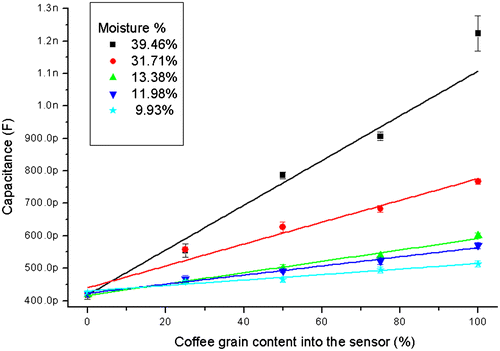
Figure shows sensor capacitance as moisture function, for different coffee grains content into the sensor, these relationships are necessary due to rotation of the coffee grains drum therefore, it is expected that coffee content into the sensor varies during drum rotation, even though as it can be seen in Figure despite the coffee grains content into the sensor varies, it is still possible to discriminate coffee moisture using sensor capacitance and evolution slope.
Figure 4. Average capacitance as moisture function, for different coffee volume that exists into the sensor.
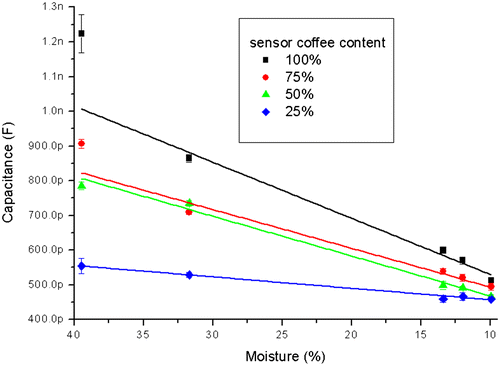
For a normal drying process, sample weight goes from 4 to 1 kg, which is less than the half of the initial weight, this wide range of sample content into the dryer allows the possibility to monitor moisture content through sample weight, Figure shows the relationship between the engine speed and the weight of the sample placed inside the dryer, it is observed that the rotation speed of the motor increases as the weight of the sample decreases because the mechanical load on the engine is lower. This characteristic behavior can be used as a cross-validation of moisture in the sample.
Figure 5. Relationship of motor rotation speed with respect to the coffee weight inside of the dryer.
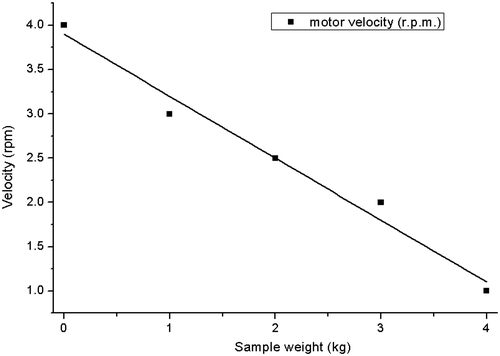
Figure shows the relationship obtained from the electric current used by the motor when submitted to different mechanical loads due to variations in the weighted sample, which can obtain an indirect measurement of the moisture present in the coffee sample.
All measurements were obtained by getting 10 points at the desired conditions, the mean values were used as a measurement point and standard deviation as error bar, under this consideration all measurements are with less than 5% error.
4. Conclusions
The development of this system to measure the moisture of coffee bean in real-time provides the coffee sector an affordable, and reliable system to improve the drying process of coffee for less than 100 US dollars. Increasing the quality of the final product, with the consistent economic benefits that entail.
The union of the two methods allows the increased system reliability while reducing the possibility of failure in measurement due to redundancy in the measurement.
Through capacitance you can know when the coffee beans have reached the recommended level of moisture for preservation, as a glance, the producer may put the coffee beans through the roasting process, when they still have a high percentage of moisture and the quality required will not be fulfilled.
Finally, the developed scale model with the developed sensors can be used in research laboratories for studying different parameters that influence the drying process.
Acknowledgments
Authors are grateful with National Center of research innovation and technological development of coffee (CENACAFE). We are also grateful to Eng. V. Vivanco Trujillo of ITO-Orizaba for his technical support.
Additional information
Funding
Notes on contributors
José de Jesús Agustín Flores Cuautle
The Master of Electronic Engineering is made up of researchers trained in various prestigious institutions around the world. It has the mission to be one of the best graduate programs in Mexico, providing cutting-edge knowledge, innovatively applying the scientific and/or technical expertise, maintaining a strong relationship with companies and prestigious institutions in searching ad hoc solutions. This research is part of the search for solutions in the agro-industrial area to improve coffee quality at different stages of production.
References
- Alessandrini, L., Romani, S., Pinnavaia, G., & Rosa, M. D. (2008). Near infrared spectroscopy: An analytical tool to predict coffee roasting degree. Analytica Chimica Acta, 625, 95–102. doi:10.1016/j.aca.2008.07.013
- División de Estrategia y Proyectos Especiales de Comercialización. (2005). Vademecum del tostador Colombiano. División de Estrategia y Proyectos Especiales de Comercialización (Ed.), (p. 290). Colombia: Federación Nacional de Cafeteros de Colombia.
- Dorfner, R., Ferge, T., Yeretzian, C., Kettrup, A., & Zimmermann, R. (2004). Laser mass spectrometry as on-line sensor for industrial process analysis: Process control of coffee roasting. Analytical Chemistry, 76, 1386–1402. doi:10.1021/ac034758n
- Dutra, E. R., Oliveira, L. S., Franca, A. S., Ferraz, V. P., & Afonso, R. J. C. F. (2001). A preliminary study on the feasibility of using the composition of coffee roasting exhaust gas for the determination of the degree of roast. Journal of Food Engineering, 47, 241–246. doi:10.1016/S0260-8774(00)00116-3
- Gautz, L. D., Smith, V. E., & Bittenbender, H. C. (2008). Measuring coffee bean moisture content. Engineer’s Notebook, 3, 1–3.
- Hall, C. W., & Arango, F. S. (1968). Equipo para procesamiento de productos agricolas. Brazil: Instituto Inter-Americano de Ciencias Agricolas de la OEA.
- Normas, D. G. D. (1986). Foods. Moisture in food products determination (Vol. NMX-F-083-1986). Mexico: Subsecretaria de Competitividad y Normatividad de la Secretaría de Economía de México.
- Oliveros Tascon, C. E., Lopez Valencia, L., Buitrago, C. M., & Moreno Cardenas, E. L. (2010). Determinacion del contenido de Humedad del cafe durante el secado en silos. Avances Tecnicos CENICAFE, 61, 108–118.
- Oliveros Tascon, C. E., Peñuela Martinez, A. E., & Jurado Chana, J. M. (2009). Controle la humedad del cafe en el secado solar, utilizando el metodo Gravimet. Avances Tecnicos CENICAFE, 387, 1–8.
- Valdecir, A. D., Daniel, M. D. Q., José Antonio, M. P., & Roberto, S. (2016). Secado de granos: Natural, solar y a bajas temperaturas. Department de AgriculturaFAO (Ed.), (pp. 1–90).
- Zimmermann, R., Heger, H. J., Yeretzian, C., Nagel, H., & Boesl, U. (1996). Application of laser ionization mass spectrometry for On-line monitoring of volatiles in the headspace of food products: Roasting and brewing of coffee. Rapid Communications in Mass Spectrometry, 10, 1975–1979. doi:10.1002/(sici)1097-0231(199612)10:15<1975:aid-rcm786>3.0.co;2-x

